Alert Suppression
Alert suppression can help you avoid alert fatigue by suppressing notifications for non-actionable alerts.
Squadcast will suppress the incidents that match any of the Suppression Rules you create for your Services. These incidents will go into the Suppressed state and you will not get any notifications for them.
These are useful in situations where you would like to view your all your informational alerts in Squadcast but do not want to get notified for them.
Prerequisites
-
The User Role associated with the user in the Team must have required permissions to manage Services (ability to manage Suppression Rules).
-
Integrate with an Alert Source and ensure that the Alert Source has started sending alerts to Squadcast before setting up Suppression Rules.
Creating Suppression Rules
Ensure that the right Team is chosen from the team picker on the top of the screen.
(1) Click on Services in the primary navigation
(2) Select a Service and click on the More options icon
(3) Click on Suppression Rules
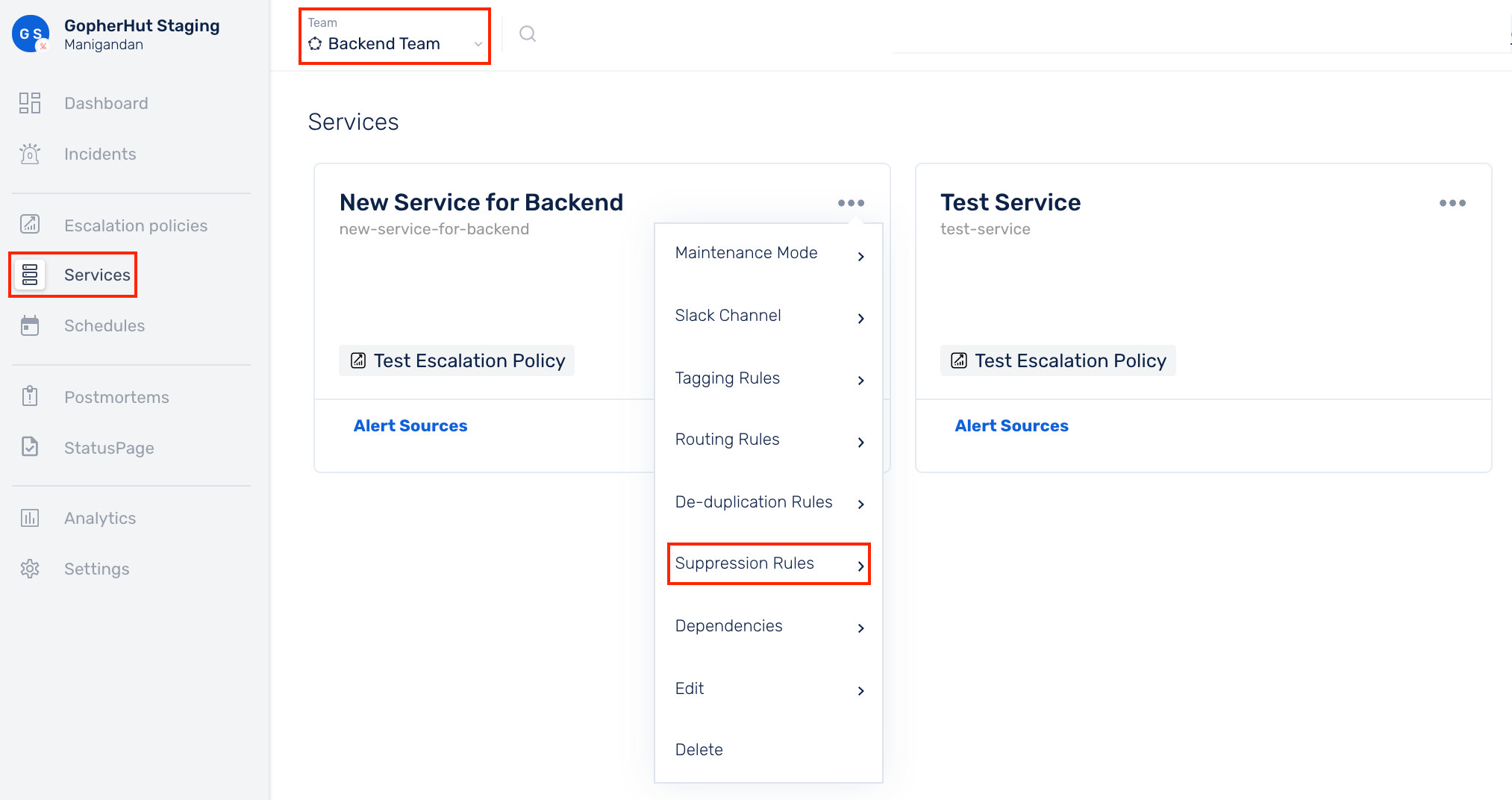
(4) Select an Alert Source from the drop-down
(5) Click on Add new rule
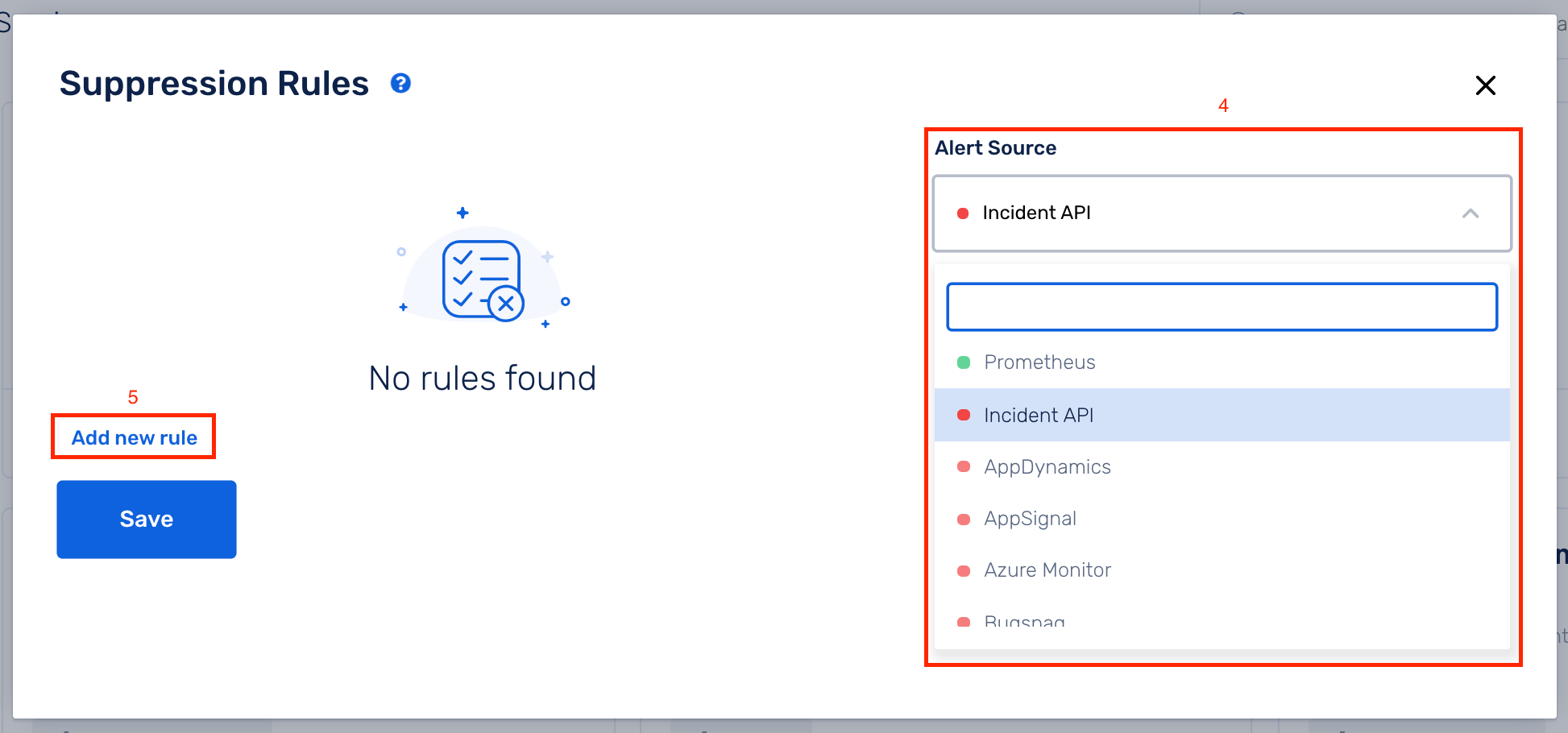
(6) Suppression Rules can be added in two different ways:
(A) UI-based Rule Builder (Beginner-friendly)
(a) On the right, you can view the payload of the latest alert for the chosen Alert Source
(b) The drop-downs in the Rule Builder contain values from the payload on the right. You can use them to easily create your Suppression Rules. As you build the expression from these drop-downs, you can also see the corresponding raw string being auto-populated for the same under String Expression.
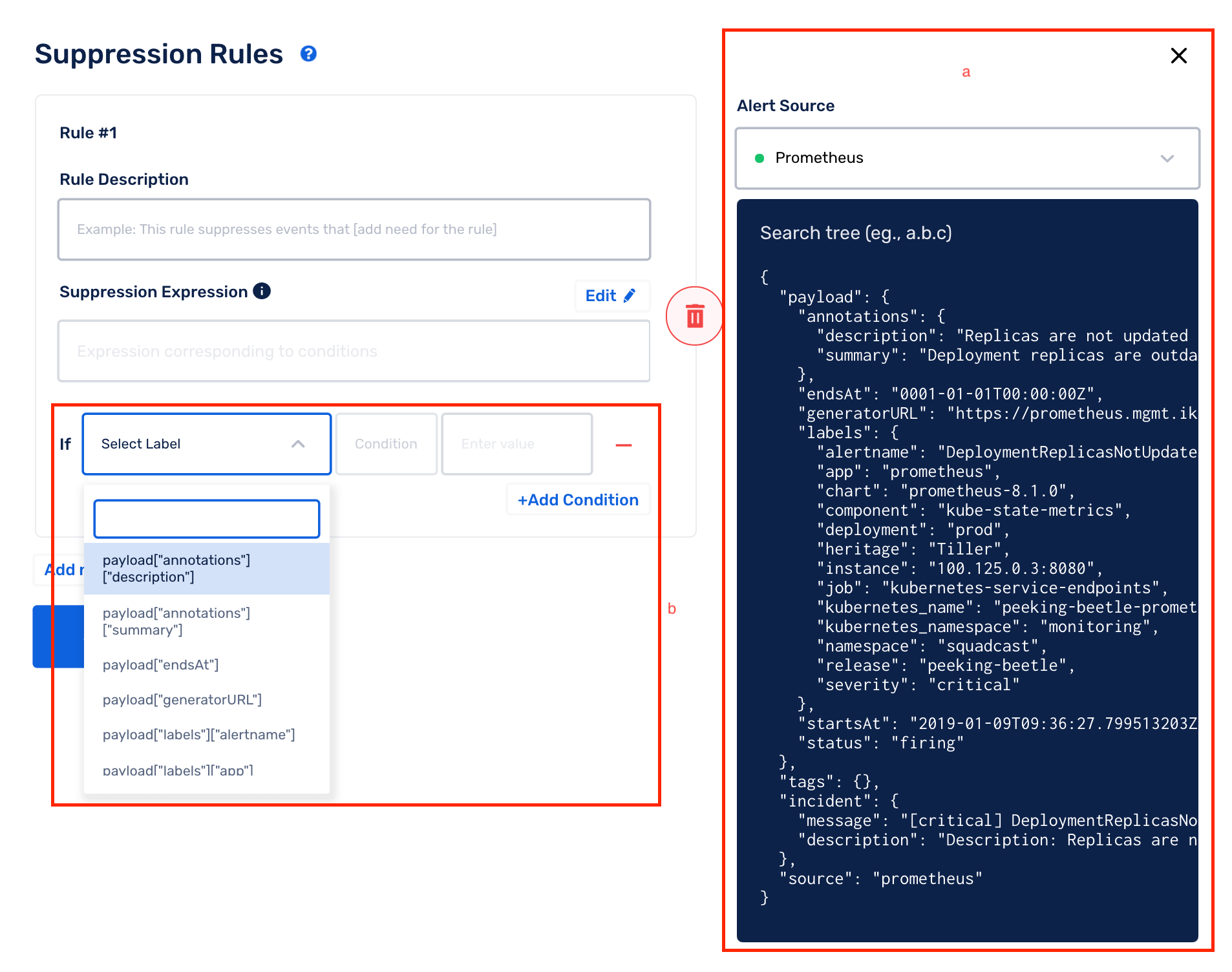
(c) You can add more than 1 condition for a rule by selecting Add Condition (a logical AND is performed between all the conditions -> the entire Suppression Rule will evaluate to True only if all the conditions evaluate to True)
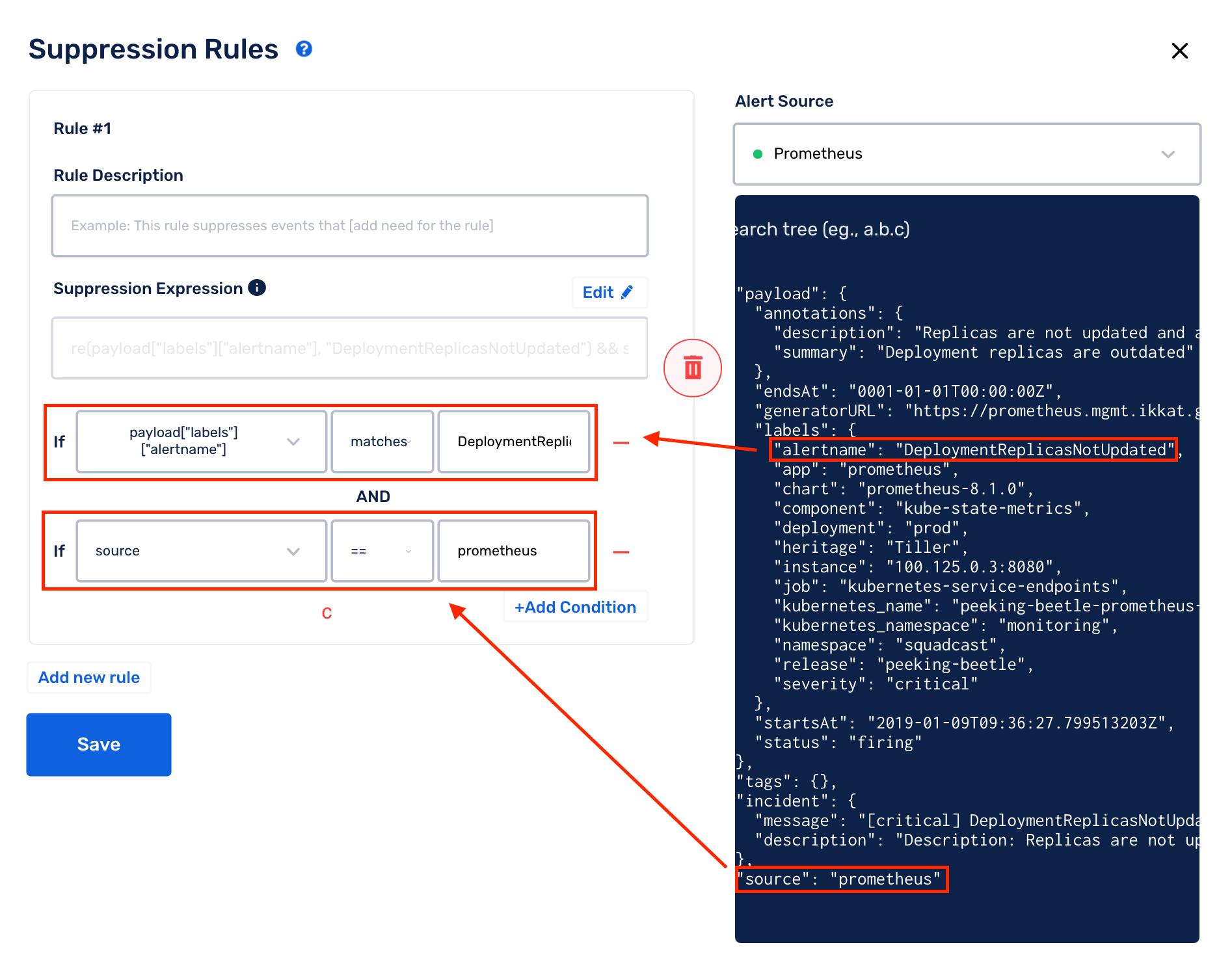
(d) You can suppress incidents based on time as well. To do so, check Suppress by time. Add details for your suppression time slot like Timezone, Duration and Repetition.
Under Duration, you can specify Start and End Dates and choose Start and End Time as well or simply run it for the entire day.
You can add Repetition for your slot, to do so, you can choose from the drop down list, while specifying the end for this repetition, as a particular date/time or never.
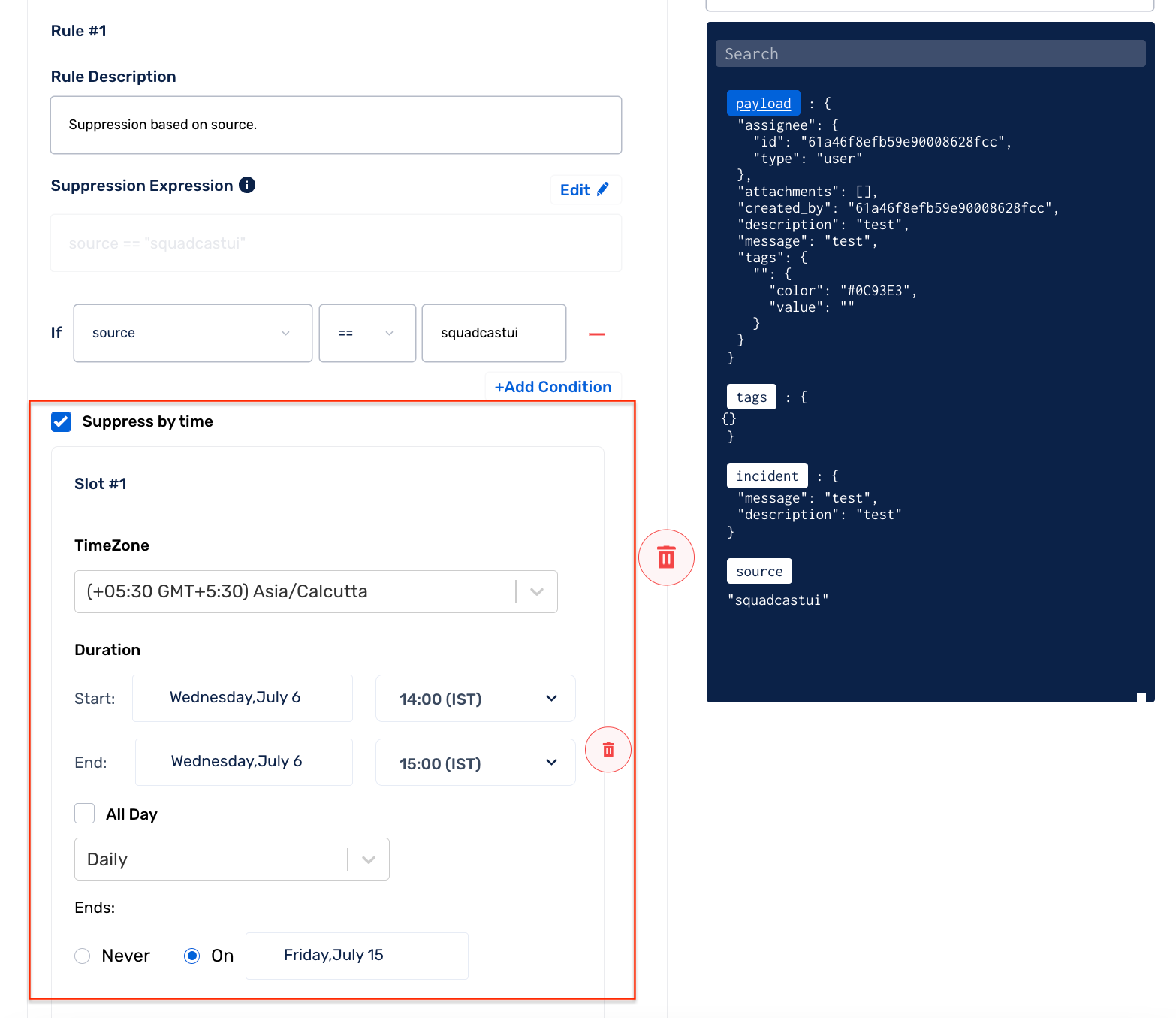
The drop-down blocks only support logical AND operator between 2 expressions. If you want to have a logical OR operation between 2 expressions, then you would have to create a new Suppression Rule.
You can also leverage comparison operators such as ==, <, <=, >, >= within your rules using the drop-down blocks, when the parameter you are evaluating against, is a numerical value from the payload to reduce alert noise.
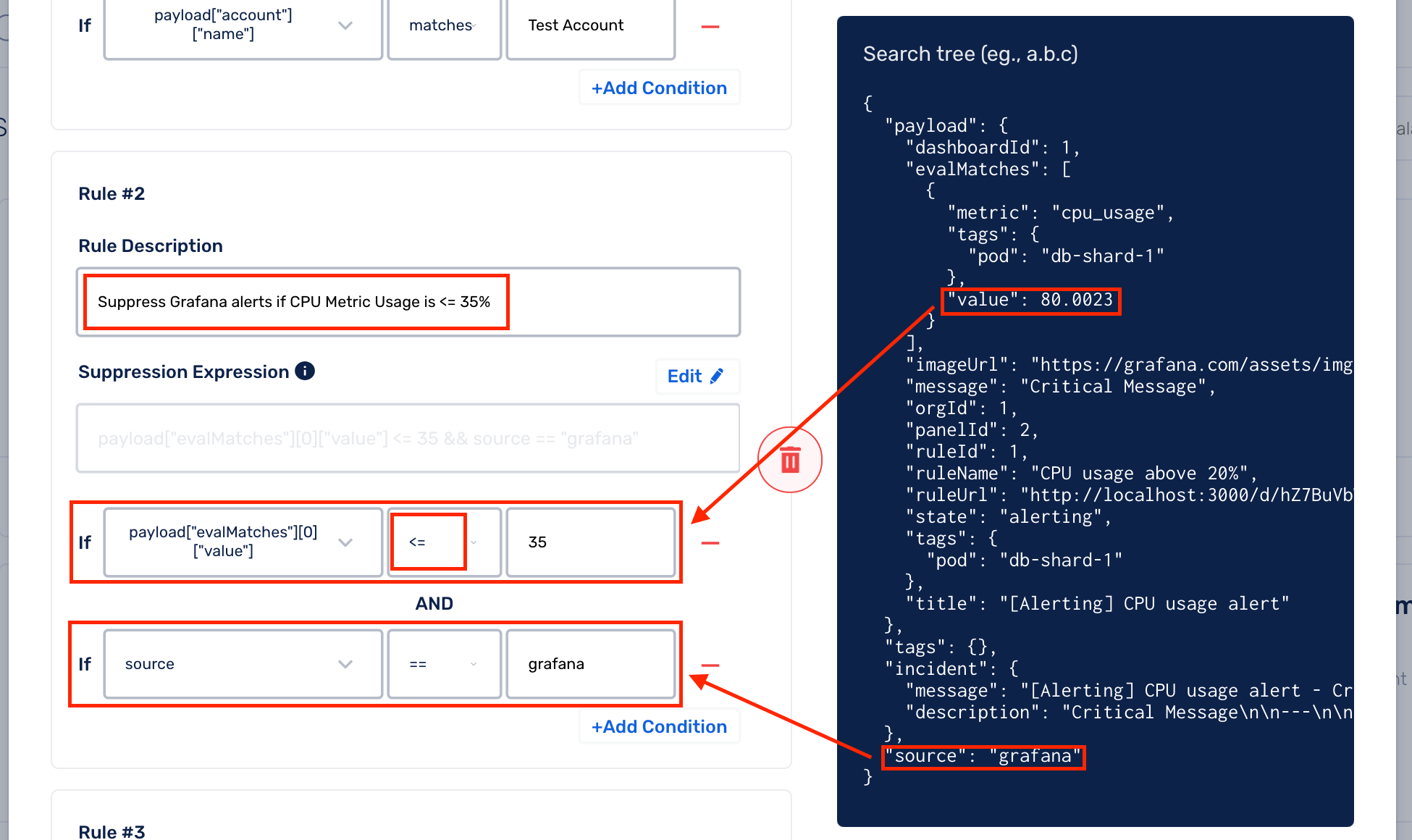
(B) Raw String Method
Once you opt for the Raw String method, you cannot revert to the UI-based Rule Builder method.
(a) On the right, you can view the payload of the latest alert for the chosen Alert Source
(b) Click on Edit to enable Raw String method
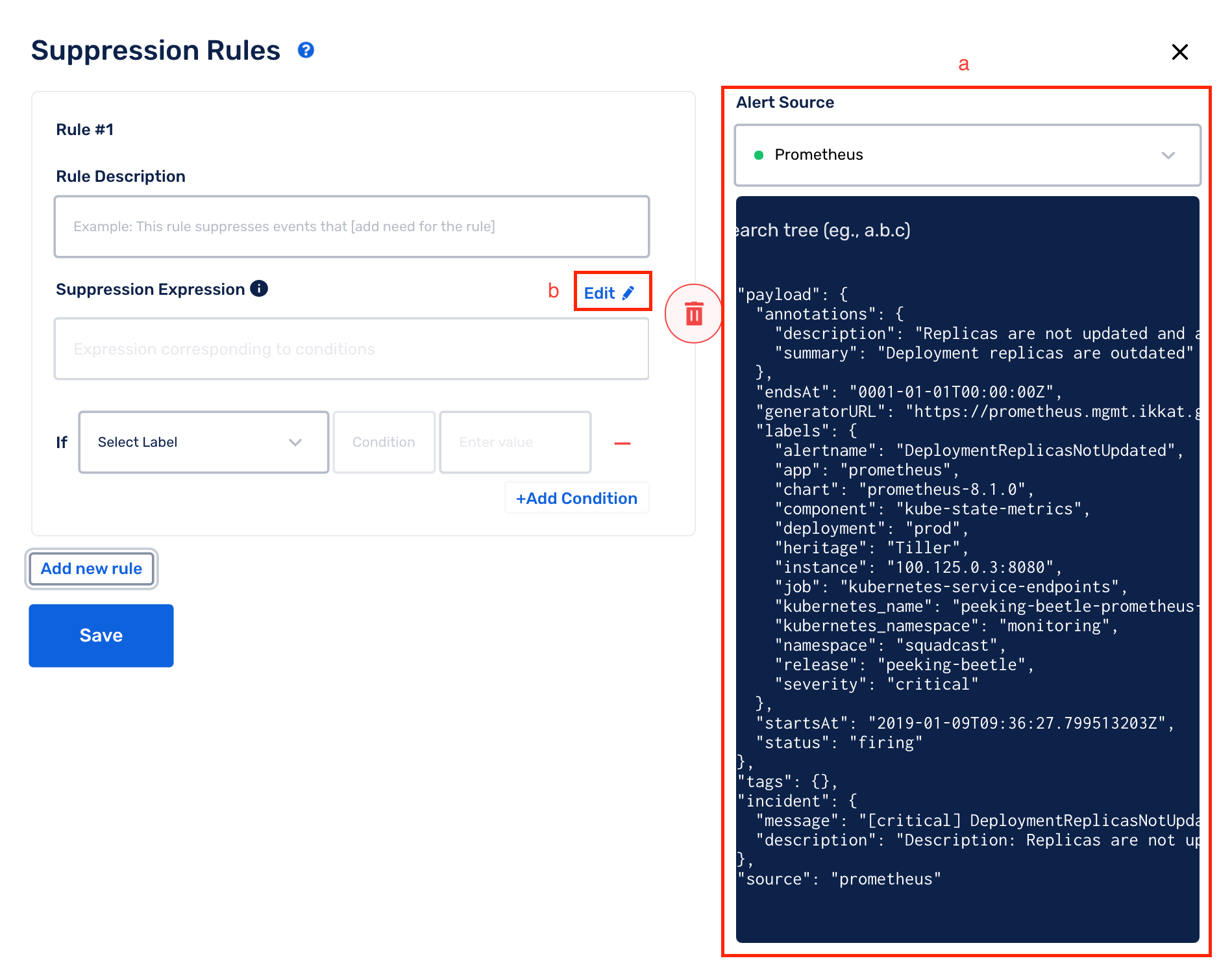
(c) Write your custom Suppression Rule expression
(d) You can suppress incidents based on time as well. To do so, check Suppress by time. Add details for your suppression time slot like Timezone, Duration and Repetition.
Under Duration, you can specify Start and End Dates and choose Start and End Time as well or simply run it for the entire day.
You can add Repetition for your slot, to do so, you can choose from the drop down list, while specifying the end for this repetition, as a particular date/time or never.
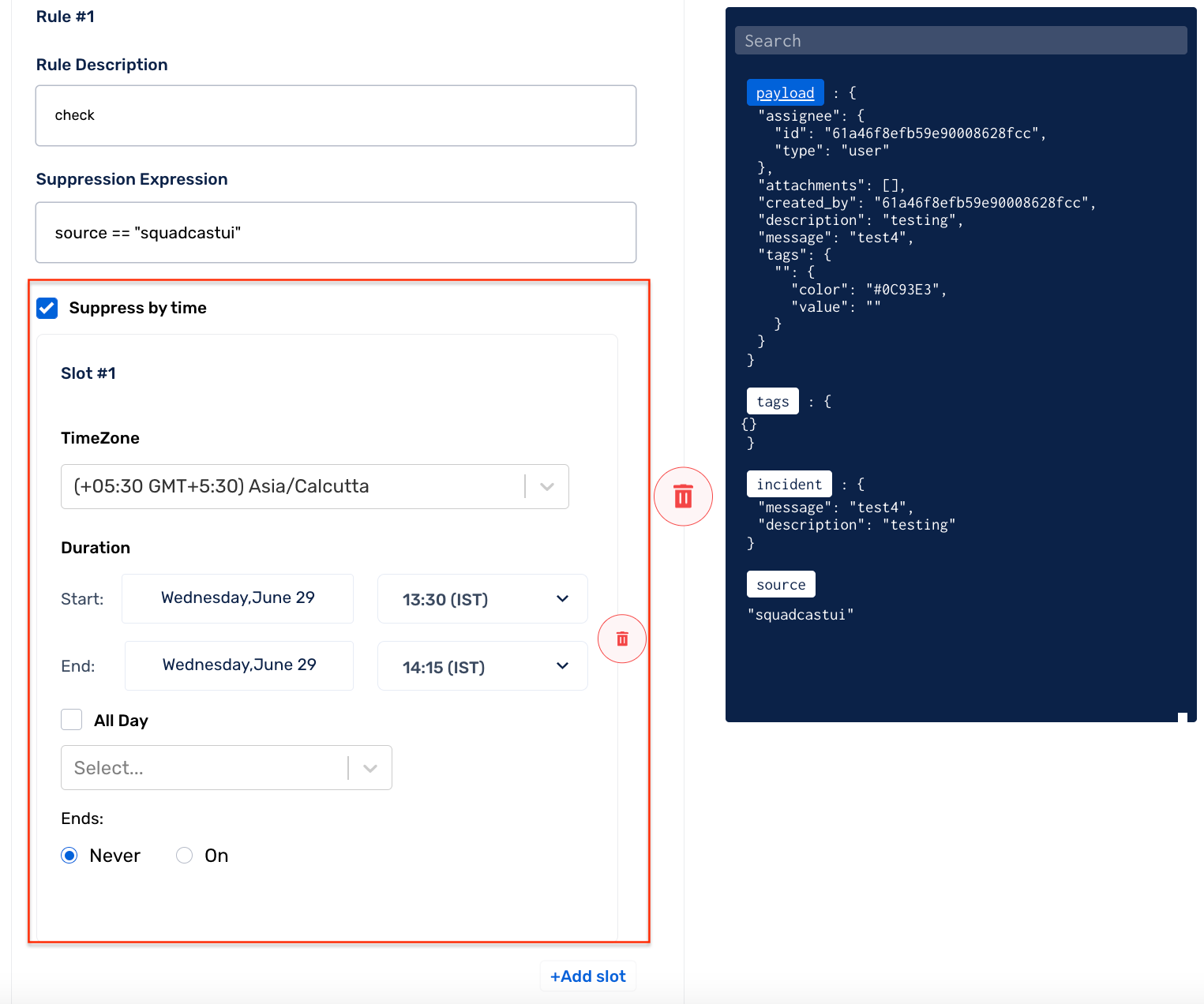
Supported Rules
The rule engine supports expressions with parameters, arithmetic, logical, and string operations. You can also check out this link to get an idea of all the expression types accepted in Squadcast.
Basic Expressions
10 > 0, 1+2, 100/3
Parameterized Expressions
payload.metric == "disk"
The available parameters are payload
payload : This parameter contains the JSON payload of an incident which will be the same as the JSON payload format for the future events for a particular alert source
payload : This parameter contains the JSON payload of an incident which will be the same as the JSON payload format for the future events for a particular alert source
payload : This parameter contains the JSON payload of an incident which will be the same as the JSON payload format for the future events for a particular alert source
incident_details: This contains the content of message and description of the incoming event
source: This denotes the associated alert source for the current/incoming event
Regular Expressions
re(payload.metric, "disk.*")
Parse JSON content within the payload using jsonPath to add a tag
General Format
jsonPath(<the JSON string that should be parsed for JSON content>, <"the parameter that needs to be picked from the parsed JSON object">)
Example
Below is an example payload:
{
"payload": {
"payload": {
"payload": {
"Type": "Notification",
"MessageId": "5966c484-5b37-58df",
"TopicArn": "arn:aws:sns:us-east-1:51:Test",
"Message": "{\"AlarmName\":\"Squadcast Testing - Ignore\",\"AlarmDescription\":\"Created from EC2 Console\"}"
}
}
jsonPath(payload.Message, "AlarmName");
This will pick out the value AlarmName from the Message object in the payload based on which, you can suppress the incident.
Multiple Alert Sources
We can see alert payloads of past events from different alert sources for the service by selecting the respective alert source from the dropdown in the right-half side.
Since the payload format is fixed for a given alert source,
it is usually preferrable to have suppression rules on a per-alert source basis.
This can be done by making use of the source field which
lets you know the alert source that triggered the incoming event.
For example, if you want to have a suppression rule for a service,
only for alerts coming for grafana alert source, then the corresponding
rule would look something like:
source == 'grafana' && (<your_suppression_rule>)
Example
Below is an example payload for demonstration:
{
"payload": {
"issue_description": "bug - 2",
"issue_id": "10029",
"issue_key": "HYD-30",
"issue_labels": [],
"issue_link": "http://13.233.254.18:8080/browse/HYD/issues/HYD-30",
"issue_priority": "Medium",
"issue_summary": "bug - 2",
"issue_type": "Bug",
"project_id": "10000",
"project_key": "HYD",
"project_name": "hydra"
},
"incident_details": {
"message": "[Bug] bug - 2",
"description": "+ Project: HYDRA \n+Issue Type: Bug ..."
},
"source": "grafana"
}
To suppress any incoming alert when:
- The alert message contains:
[Bug] - The alert source is
grafana
Suppression Rule:
re(payload.incident_details.message, "[Bug]") && source == "grafana";
Discarding suppressed incidents
To discard incoming alerts and stop them from being triggered as incidents in Squadcast,
use the discard() function in conjunction with Suppression Rules.
Example
Suppression Rule:
source == "grafana" && re(payload["message"], "Notification Message");
Supression Rule with discard():
source == grafana &&
re(payload["message"], "Notification Message") &&
discard();
Avoid hitting Rate Limits
The discard() function can be used to avoid hitting the
Incident Rate Limits
as Suppressed events that are discarded don’t get counted against the allowed rate limits.
Viewing Suppressed Incidents
You can view suppressed incidents in the Incidents page by clicking on All Incidents and choosing Suppressed as highlighted in the screenshot below.
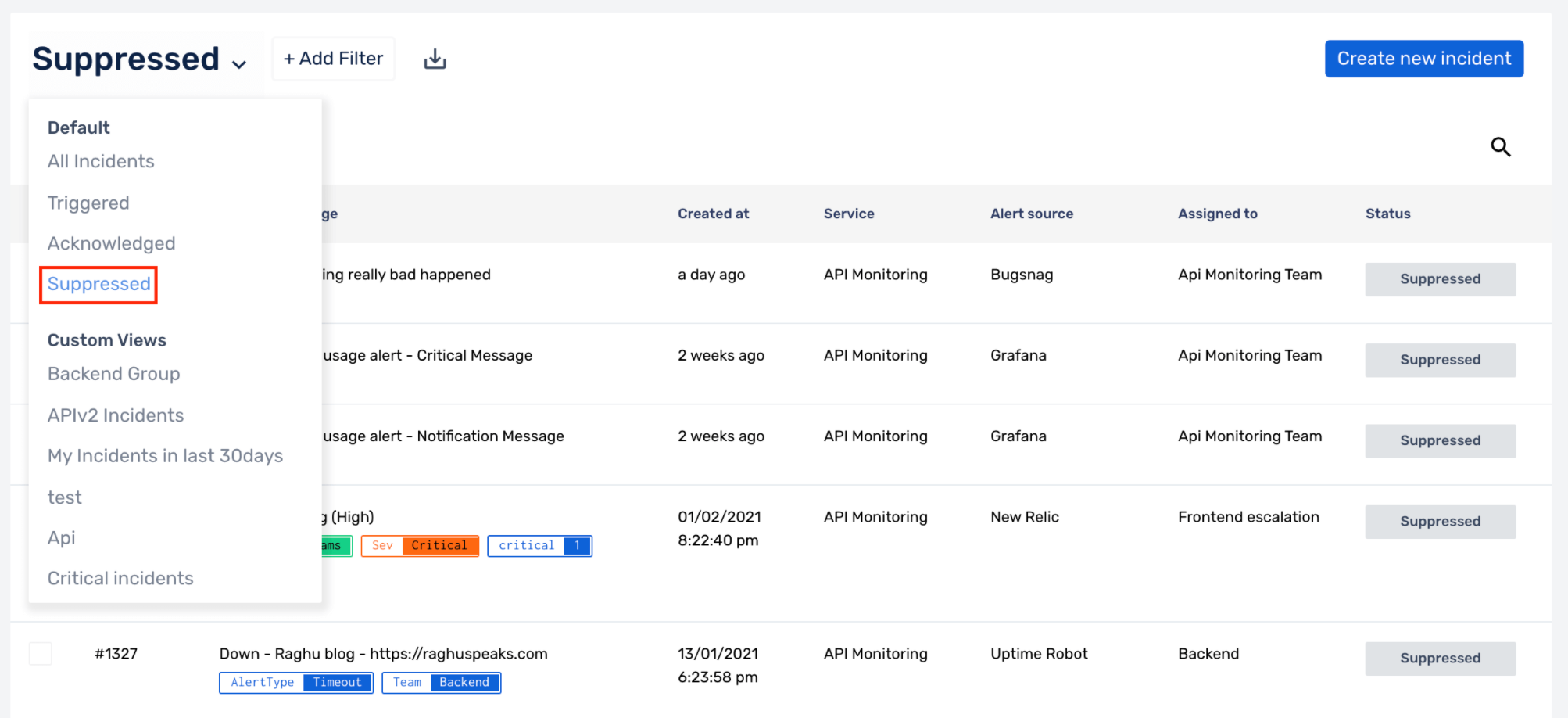
Note
SuppressedandResolvedare the final states for incidents in Squadcast. You will not be able to take any action on incidents that are in these states.- Incident information will be available on the Squadcast platform even if they are suppressed.
FAQs
(1) What kind of regex can be used to write custom rules?
The rule engine supports expressions with parameters, arithmetic, logical, and string operations. You can also check this out to get an idea of all the expression types accepted in Squadcast. Please do your regex here against Golang flavour as shown in the screenshot below and then, set them up in Squadcast:
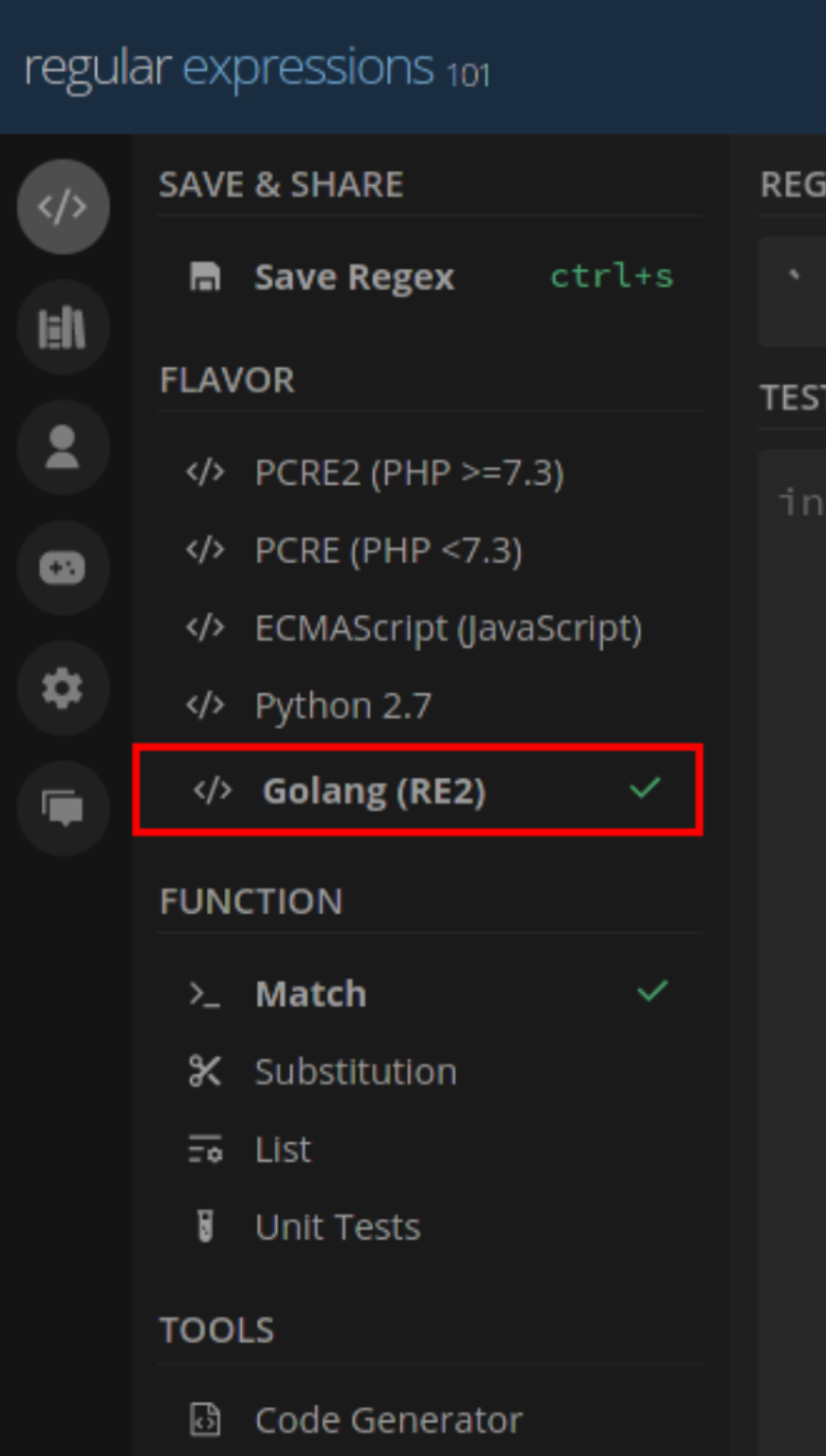
(2) Can I create OR rules?
Yes, you can. The evaluation between different Suppression Rules is OR. Add multiple Suppression Rules to enable OR evaluation.
(3) While adding a Suppression Rule, is the search string in the rule case sensitive?
Yes, that is correct. For example, if your seach string is “ALERT” and your payload does not contain “ALERT” but contains “Alert”, this will not be matched. Your search string should be “Alert”.
(4) How do I know if an incident gets suppressed due to a Suppression Rule?
In the Incident’s Activity Timeline the reason for suppression is displayed.
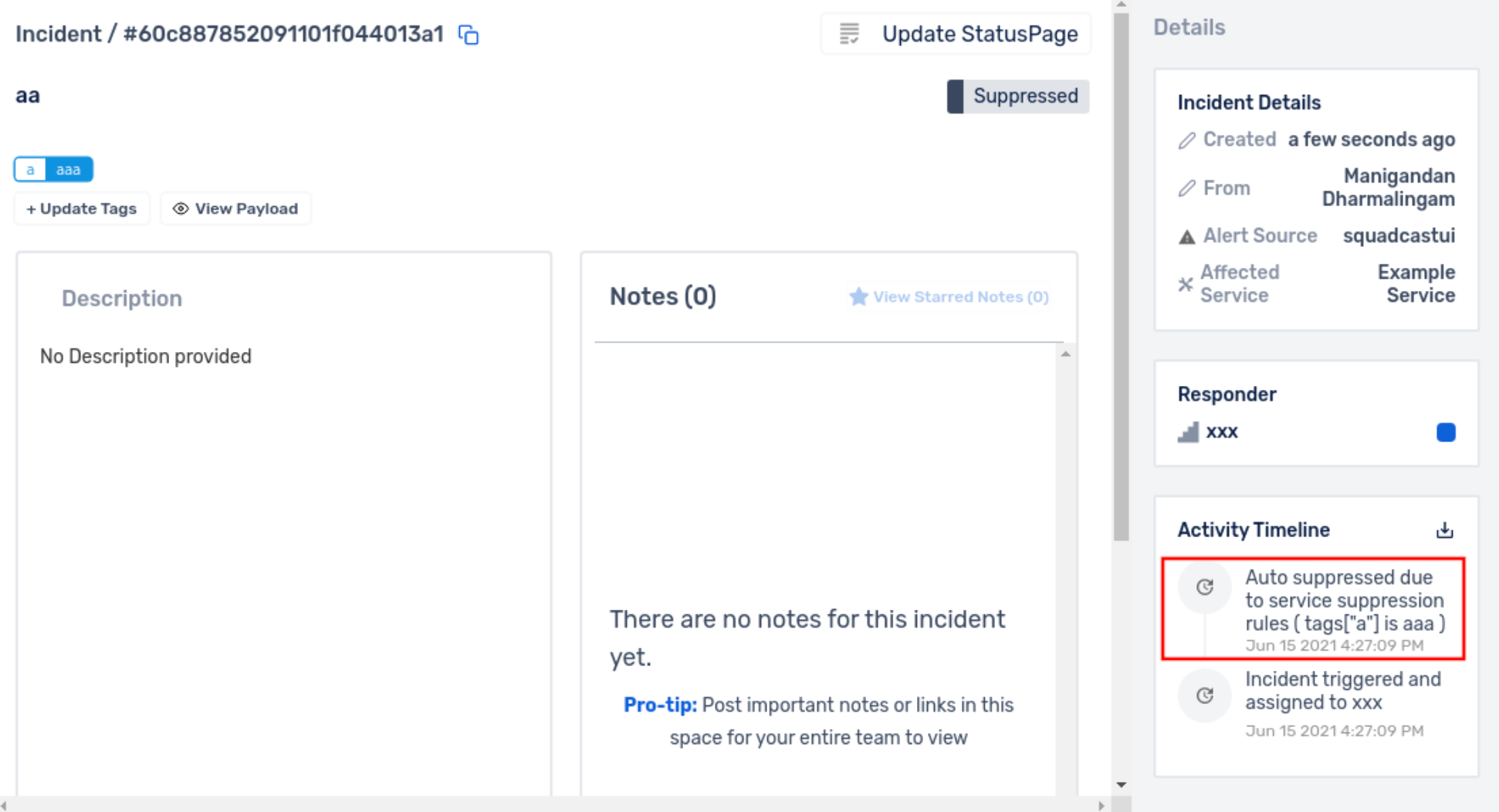
(5) I have configured multiple rules for a particular Service. Can I search through the configured rules to find the rule I am looking for?
Yes, that is doable. You will notice a Search option on the left-top of the rules modal. You can type in a word you recall from the rule description or the rule itself. Any matching results will yield the narrowed down set of rules.
